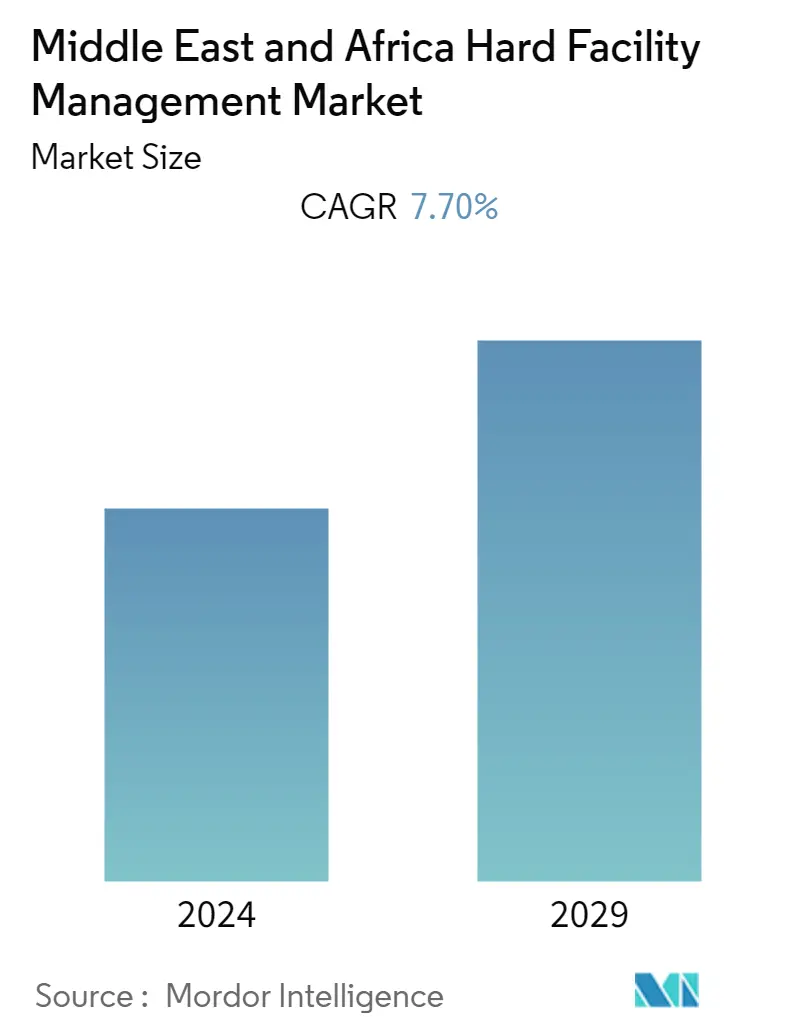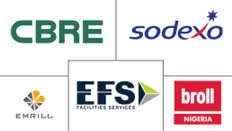Market Size of Middle East and Africa Hard Facility Management Industry

| Study Period | 2019 - 2029 |
| Base Year For Estimation | 2023 |
| Forecast Data Period | 2024 - 2029 |
| Historical Data Period | 2019 - 2022 |
| CAGR | 7.70 % |
| Market Concentration | Low |
Major Players
*Disclaimer: Major Players sorted in no particular order |
MEA Hard Facility Management Market Analysis
The Middle East and Africa Hard Facility Management (HFM) Market revenue is expected at a CAGR of 7.7% over the next five years. The region's HFM market is anticipated to grow due to increased building activity and rising demand from the commercial and residential sectors.
- The HFM sector is developing in the GCC nations. With the current oil prices encouraging capital investment, more new projects are expected to be launched. As a result, the HFM sector would eventually keep expanding. Notably, governmental and semi-governmental organizations are multiplying and are actively looking for certified foreign FM service providers for facilities. The Vision 2030 economic development strategy is aligned with the focus on building and construction. The plan aims to boost connectivity, industry, housing, and infrastructure.
- Notably, to build high-priority distributed infrastructure networks in South Africa by 2050, the Department of Public Works and Infrastructure (DPWI) introduced NIP 2050, which provides a strategic vision and roadmap. It emphasizes decentralized infrastructure with stronger linkages to local companies and communities.
- The region's facility management industry is expected to develop most rapidly in Saudi Arabia, the United Arab Emirates, and Qatar due to the rising commercial real estate demand of these countries. Also, Dubai and Saudi Arabia have many multinational corporations that led to tax reductions and created an area with a favorable economic environment. As Sheikh Hamdan bin Mohammed confirmed in June this year, the Dubai Global network seeks to increase investment, expand markets, and provide worldwide exposure to domestic businesses.
- Independent organizations, like the South African Facilities Management Association (SAFMA), aggressively promote awareness and extension of the sector to encourage future domestic FM development. As one of the first developing nations to offer local HFM standards to assist enterprises in enhancing HFM efficacy, South Africa is highlighted by the newly released SANS 1752- Strategic Facilities Management System.
- However, difficulties with operational costs and a lack of infrastructure in the area are anticipated to impede market expansion. As it is well known that money plays a crucial role in the execution of any activity or function. The main obstacles to HFM services in Nigerian tertiary institutions have been attributed to inadequate funding. Although federal programs and foreign investment activities for infrastructure development are anticipated to create commercial prospects in the region over time, the economy needs more investor confidence.
- Middle East is one of the most prominent players in the HVAC services market of all time. The expansion of the HVAC business in this suggests that service providers would have attractive opportunities in the years to come since the sale of equipment generates a significant demand for installation, retrofitting, maintenance, and repair services. As the largest market for HVAC systems, the commercial sector would provide the majority of the opportunities.
- In the initial stage of COVID-19 outbreak, Middle East and Africa's infrastructural development stalled for a certain time along with the rest of the world. However, the region is bouncing back steadily. Now, HFM services have a new importance in the entire ecosystem. With the rising demand for air purification services to the building of new work-space designs for social distancing, HFM services are one of the key areas in the infrastructurally developed regions of the Middle East.
MEA Hard Facility Management Industry Segmentation
The Middle East and Africa Facility Management (HFM) services manage the technology, systems, and equipment that make up a company's physical structure.
The Middle East and Africa Hard Facility Management Market are segmented By Type (MEP -Mechanical, Electrical, Plumbing, and HVAC Maintenance services, Enterprise Asset Management, and Other Types), By End-Users (Commercial, Institutional, Public/Infrastructure, Industrial, and Other End-Users), and By Geography (Saudi Arabia, United Arab Emirates, Qatar, Kuwait, South Africa, Egypt, Nigeria, and Rest of Middle East and Africa).
The market sizes and forecasts are provided in terms of value (USD million) for all the above segments.
| By Type | |
| MEP (Mechanical, Electrical, Plumbing), and HVAC Maintenance Services | |
| Enterprise Asset Management | |
| Other Types |
| By End-User | |
| Commercial | |
| Institutional | |
| Public/Infrastructure | |
| Industrial | |
| Other End-Users |
| By Geography | |
| Saudi Arabia | |
| United Arab Emirates | |
| Qatar | |
| Kuwait | |
| South Africa | |
| Egypt | |
| Nigeria | |
| Rest of Middle-East and Africa |
Middle East and Africa Hard Facility Management Market Size Summary
The Middle East and Africa Hard Facility Management (HFM) market is poised for significant growth, driven by increased construction activities and rising demand from both commercial and residential sectors. The Gulf Cooperation Council (GCC) countries are at the forefront of this expansion, with capital investments spurred by favorable oil prices. Governmental initiatives, such as Saudi Arabia's Vision 2030 and South Africa's National Infrastructure Plan 2050, are pivotal in shaping the market landscape. These strategies focus on enhancing connectivity, infrastructure, and economic diversification, which in turn bolster the demand for HFM services. The region's facility management industry is expected to thrive, particularly in Saudi Arabia, the United Arab Emirates, and Qatar, due to the burgeoning commercial real estate sector. Despite challenges like operational costs and infrastructural deficits, the market is supported by foreign investments and strategic partnerships aimed at infrastructure development.
The HVAC services market within the HFM sector is also experiencing robust growth, particularly in the UAE, where the construction boom necessitates extensive HVAC system maintenance and installation. The region's hot and humid climate further drives the demand for efficient HVAC solutions. Post-COVID-19, there is an increased emphasis on air quality and purification, making HVAC services crucial in commercial spaces. The market is moderately fragmented, with key players like Sodexo, EFS Facilities Services Group, and Emrill Services LLC leveraging technology and innovation to enhance their service offerings. These companies are actively expanding their portfolios and adopting sustainable practices, such as carbon emission reduction and waste management, to align with regional environmental goals. As the Middle East and Africa continue to develop, the HFM market is expected to play a vital role in supporting the region's infrastructure and economic ambitions.
Middle East and Africa Hard Facility Management Market Size - Table of Contents
-
1. MARKET INSIGHTS
-
1.1 Market Overview
-
1.2 Industry Attractiveness-Porter's Five Forces Analysis
-
1.2.1 Bargaining Power of Suppliers
-
1.2.2 Bargaining Power of Consumers
-
1.2.3 Threat of New Entrants
-
1.2.4 Threat of Substitute Products
-
1.2.5 Intensity of Competitive Rivalry
-
-
1.3 Impact of COVID-19 on the Facility Management Industry
-
-
2. MARKET SEGMENTATION
-
2.1 By Type
-
2.1.1 MEP (Mechanical, Electrical, Plumbing), and HVAC Maintenance Services
-
2.1.2 Enterprise Asset Management
-
2.1.3 Other Types
-
-
2.2 By End-User
-
2.2.1 Commercial
-
2.2.2 Institutional
-
2.2.3 Public/Infrastructure
-
2.2.4 Industrial
-
2.2.5 Other End-Users
-
-
2.3 By Geography
-
2.3.1 Saudi Arabia
-
2.3.2 United Arab Emirates
-
2.3.3 Qatar
-
2.3.4 Kuwait
-
2.3.5 South Africa
-
2.3.6 Egypt
-
2.3.7 Nigeria
-
2.3.8 Rest of Middle-East and Africa
-
-
Middle East and Africa Hard Facility Management Market Size FAQs
What is the current Middle East and Africa Hard Facility Management Market size?
The Middle East and Africa Hard Facility Management Market is projected to register a CAGR of 7.70% during the forecast period (2024-2029)
Who are the key players in Middle East and Africa Hard Facility Management Market?
EFS Facilities Services Group, Emrill Services LLC, Sodexo Inc., CBRE Group Inc and Broll Nigeria are the major companies operating in the Middle East and Africa Hard Facility Management Market.

